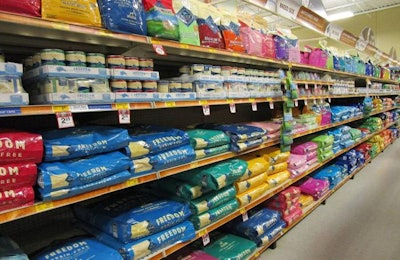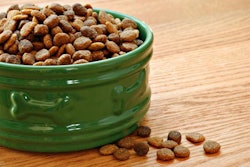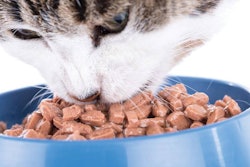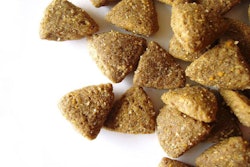
The majority of pet food and other pet products in the US is sold in two broad retail channels: pet specialty and mass market. A third channel, online, is growing in significance and size, especially among Millennial pet owners; but currently most of the action for pet food is in the two largest channels. And that action is worth examining.
New data from Packaged Facts show that while shopping for pet products (not just pet food) in the pet specialty channel has remained fairly steady for US pet-owning households, mass market’s influence has waned. Specifically, when Packaged Facts surveyed pet-owning households about where they shopped for pet products in 2010 (choosing all channels that applied), a cumulative percentage of 89.6% said they shop mass market retailers, such as supermarkets, discount stores and wholesale clubs. By 2015, that cumulative percentage had dropped to 78.6%.
Meanwhile, the cumulative percentage for pet products bought in pet specialty—pet superstores, other pet stores and veterinary clinics—was 77% in 2010 and 75.7% in 2015, according to Packaged Facts. Online sales of pet products, which rose from 7% in 2010 to 9.3% in 2015, seem to account for the drop-off in mass market shopping by pet owners.
David Sprinkle, research director for Packaged Facts, attributes the increase in online sales to the growing influence of Millennial pet owners. (Sprinkle presented this information at Global Pet Expo in Orlando, Florida, USA, in March 2016, and will present pet food data and trends focused on high-meat formulations and novel proteins at Petfood Innovation Workshop, April 18 in Kansas City, Missouri, USA.)
As the number of Millennial pet owners continues to rise and, correspondingly, their pet product spending power increases, online sales will no doubt keep growing, too. Yet for now, peering into the pet food sales picture in US pet specialty and mass market reveals some interesting insights.
For the US pet specialty channel, Packaged Facts derives most of its data from GfK’s comprehensive tracking of pet food sales in pet retail (superstores and independents), veterinary clinics and farm and feed stores. Those retail outlets, a total of about 54,000, accounted for US$13.1 billion in pet food sales in 2015, according to Maria Lange, business group director of pet care for GfK. That represents 4% growth over 2014 pet food sales in the US pet specialty channel. (Lange will be presenting this and other data in-depth at Petfood Forum 2016, April 19 in Kansas City.)
Not surprisingly, the pet retail segment owns the largest share of pet food sales in US pet specialty, at US$7.9 billion, yet veterinary sales (US$1.7 billion) and farm and feed sales (US$3.5 billion) are growing slightly faster. Sales increases from 2014 to 2015 in those segments were 4.7%, 5.3% and 5.0%, respectively.
The reason overall pet food sales growth reports at only 4% is because those dollar sales increases are offset by a decline in poundage (volume) sales of 1.3%. Lange attributes the decrease in poundage to the rising number of small-breed dogs, the popularity of low-weight pet diets and the growth in e-commerce, as some pet owners opt to order their pet food online rather than buying in brick-and-mortar outlets. (There we go with online sales again!)
To me, one of the most interesting points in Lange’s analysis is the fact that premiumization of pet food in US pet specialty may be leveling off. While the average price per pound of pet food and treats sold in this channel rose 40% from 2011 to 2015—from US$1.71 per pound to US$2.40—the increase from January 2015 to January 2016 was only 7%, to US$2.42. The proliferation of natural products in all categories and channels (or at least products labeled as natural) has led to a growing number of “value natural” pet food offerings that typically cost about 20% less than smaller, premium natural products, Lange says.
On the mass market side, Packaged Facts’ data may help support this theory: among the largest dry dog food brands (with annual sales of $20 million or more), those growing the fastest in sales cost two to three times more than the mass market pet food average of US$.73 per pound—yet still less than the US$2.42 in pet specialty. For example, Purina Beyond’s dry dog food, which grew a whopping 226% in sales in 2015, costs an average of US$2.06 per pound. Evolve Pet Food, from Sunshine Mills, costs US$1.43 average per pound, and its sales increased 55.5% in 2015.
Sprinkle’s presentation did not include further data on mass market pet food sales or channel shopping habits by demographic. Yet he did provide results of a national survey of US pet owners his firm has conducted for several years, showing that the number of owners who say they “look out for lower prices, special offers and sales on pet products” has remained consistent at about 71% total. Another sign, perhaps, of premiumization’s waning influence?
















